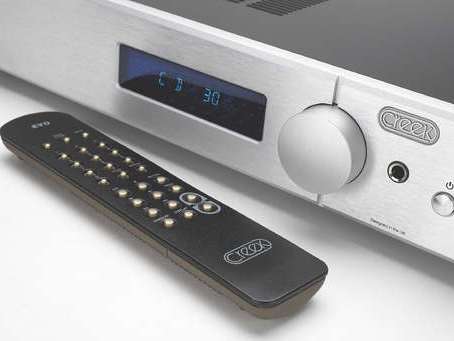TechRadar Verdict
A useful range of abilities, which add up to an extremely detailed, superbly dynamic and punchy amplifier with a happy line in melody, too. Being outrageously well made for the price seals the deal
Pros
- +
Drive and attack are good
Lovely design
Good value for money
Cons
- -
Midrange appears to have coloration in upper ranges
Why you can trust TechRadar
The Evo range is Creek's latest addition and has been available for just a few months. When we first reviewed this amplifier, with its partnering CD player we commented that Creek's no-frills reputation hardly fits with the super-smart appearance of Evo.
Now, putting the amp side by side with its peers, we are even more impressed. Sleek, minimalist appearance, robust case with thick aluminium front panel and healthy power rating - have corners been cut somewhere inside?
Emphatically... no! Pulling off the lid reveals a very smart assemblage of high-quality electronic components, all through-hole types of good rating and mounted on a single circuit board. There's a large toroidal transformer feeding banks of electrolytic capacitors (Creek prefers multiple small units to lone big ones)
While the bipolar output transistors are mounted on a healthy-looking internal heatsink. Inputs are switched by relays mounted right beside the sockets and the selected signal is buffered by high-quality op-amps before being passed to an electronic volume control.
Had we been shown this amp and asked to guess its price, the answer would have been considerably in excess of the correct one. It's pleasant to use and flexible too, with the option of upgrading the 'aux' input to phono (by installing a small internal circuit board). About the only areas where it lags the other amps are input and output provision: there's one less line input than most and only one set of speaker terminals. Worse things happen!
Reviewing the Evo sighted and with its partnering CD player, we felt it had a distinct character of its own. This time around, unaware of its identity and with the same source equipment that supplied the other amps, our unsighted listeners were less inclined to use the term 'character', but they still seem to have found some distinctive features to comment on.
Drive and attack
They agreed with our finding that drive and attack are good, but seemed rather divided over the deepest reaches of the bass, one finding it very well extended, another just a shade dry.
Bass is only part of the formula for attack, though, and the Evo's midrange does appear to have a little coloration in its upper ranges, which adds some 'speed' to the sound. In anything more than very modest amounts, this can be tiring to listen to.
However, Creek has kept this coloration well within the limits of comfort and has also balanced it well against the high treble, which is notably open and sweet. Melody lines thus come out spick, span and shining, and detail is very good.
Imaging is interesting. It's very precise and stable side-to-side, but with limited depth. There is great stability in the depth dimension, though, which does a lot to compensate. Meanwhile, the mild coloration has varying effects depending on musical forces, with vocals (both male and female) being typically lifted out of their backing.
This is occasionally disconcerting but not unpleasant. Symphony orchestra can become strident on occasion, our listeners found, but smaller classical ensembles and most kinds of jazz and pop bands simply sound lively and energetic. If those last two adjectives (and add 'tuneful' for good measure) appeal to you, so will this amp.
LAB REPORT
Creek's technical specifications tally closely with our own findings, including output power: a fairly typical 85W, which nearly doubles into 4 ohms. Dynamic peak power scores relatively well thanks to the large power supply capacitance available. Frequency response is wide and output impedance low across most of the frequency range, rising just a little in the high treble. Noise is good though a little behind the group's best.
Distortion is good but not outstanding, and its spectrum contains quite a few harmonics. In addition, it drops off quite slowly with decreasing output level and we'd wager that it is responsible for a good deal of the amp's character. However, it remains well suppressed at high frequencies and it shows minimal signs of phase modulation in the intermodulation plots. Power consumption is the lowest of any amp here, equivalent to about 2.5p per day running costs. There is no power standby.
Tech.co.uk was the former name of TechRadar.com. Its staff were at the forefront of the digital publishing revolution, and spearheaded the move to bring consumer technology journalism to its natural home – online. Many of the current TechRadar staff started life a Tech.co.uk staff writer, covering everything from the emerging smartphone market to the evolving market of personal computers. Think of it as the building blocks of the TechRadar you love today.
